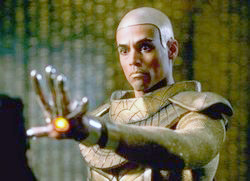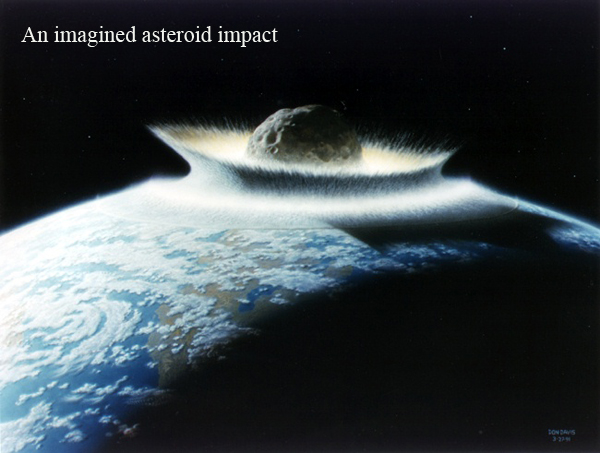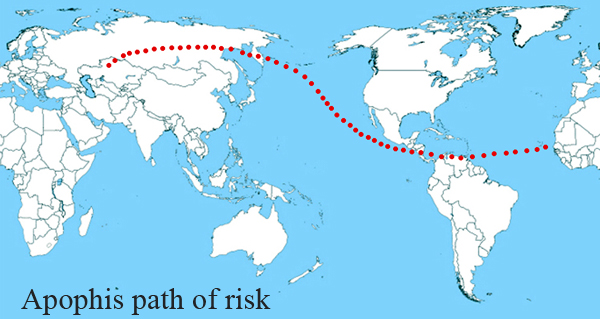Vredefort and Apophis
Today, Vredefort and Apophis. The University of Houston's College of Engineering presents this series about the machines that make our civilization run, and the people whose ingenuity created them.
The quarter-mile-wide Apophis asteroid will pass near earth in 2036. In 2008, NASA estimated one chance in 45,000 that it would hit us. Other estimates have suggested a higher likelihood that we'll be hit, but the odds remain very slim.
 Still, NASA's making plans, just in case: We might place a gravitational attractor near it to pull it off course. We might blow it to bits with a nuclear weapon, nudge it by ramming it with a space vehicle, or attach a rocket motor to it. If did hit us, it'd be considerably worse than the 1883 Krakatoa eruption. Hence the name Apophis, Greek name of the Egyptian demon, Apep. He was popularized as the Goa'uld villain in the TV series StarGate.
Still, NASA's making plans, just in case: We might place a gravitational attractor near it to pull it off course. We might blow it to bits with a nuclear weapon, nudge it by ramming it with a space vehicle, or attach a rocket motor to it. If did hit us, it'd be considerably worse than the 1883 Krakatoa eruption. Hence the name Apophis, Greek name of the Egyptian demon, Apep. He was popularized as the Goa'uld villain in the TV series StarGate.
For comparison, the 110-mile-diameter Chicxulub Crater in Yucatan was formed 65 million years ago when a six-mile-wide meteor struck. That's the impact that some think caused the dinosaur extinctions -- although it seems to've happened a third of a million years too soon. More likely, the dinosaurs survived Chicxulub -- then perished as victims of climate change. The Chicxulub meteor had roughly ten thousand times time the mass of Apophis. And its name is equally sinister. It means Tail of the Devil.

So what was the worst impact after Earth was fully formed? Perhaps it was one that occurred two billion years ago when a meteor struck South Africa. It left behind the 200-mile-diameter Vredefort Crater. At the time, life on Earth consisted of elementary cells that lived in an atmosphere, very low in oxygen. After the Vredefort meteor, oxygen levels rose and more complex biological forms followed.
The violence of the Vredefort meteor could well have dissociated oxygen and increased atmospheric levels. It could've begun the evolutionary progression that eventually yielded such complexities as humans, whales, and elephants.
But I said perhaps it was largest. That's because we have another contender -- an anomaly, out of sight, beneath the deep ice of the Antarctic region called Wilke's Land. It's inaccessible, but if it does prove to be a crater, it's 1-1/2 times Vredefort's diameter. It could possibly account for yet another mass extinction that occurred on the threshold of the dinosaur era.
Incomprehensibly large as these events are, they're so rare that they leave us untroubled. They could crush us like bugs, but our lives are so brief in comparison with their frequency, that we can shrug them off. Our concern is with this year's earthquake, war, or hurricane.
Vredefort occurred when Earth was half its present age. Yet, even little Apophis could be worse than a third world war if it hit us. Small chance it will, but we can be glad that NASA is taking it seriously. Thank Heaven that we'll almost certainly have the means to defend against it, should that need actually arise.
I'm John Lienhard at the University of Houston, where we're interested in the way inventive minds work.
Science, Vol. 325, 28 August 2009, pg. 1048
See the Wikipedia articles on the Vredefort Crater, the Apophis Asteroid, the Chicxulub Crater, and the Timeline of Evolution. All images courtesy of NASA.

NASA diagram showing a locus of points where Apophis might strike in the rare instance it actually were to hit Earth